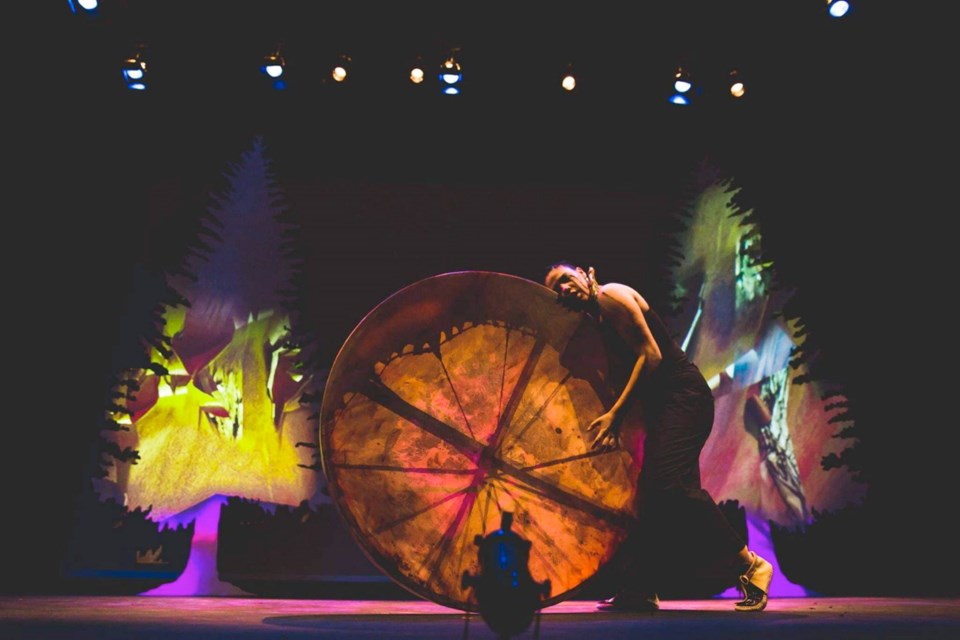ON STAGE
What: Supernova: Performances That Heal
Where: Belfry Theatre, 1291 Gladstone Ave.
When: Jan. 11 (7 p.m.) and Jan. 12 (1:30 p.m. and 7 p.m)
Tickets: $30 from tickets.belfry.bc.ca
Lindsay Katsitsakatste Delaronde made such an impact during her first term as the City of Victoria’s Indigenous Artist in Residence, her contract — a first for the city — was extended 10 months.
Her run comes to a close next week with a showcase of traditional song, dance and storytelling, a fitting finale for what has been two years of learning, renewal and reconciliation for the University of Victoria grad.
“I’ve got to give props to the city for allowing a program like this and allowing me to step into it,” Delaronde said of her service as the inaugural Indigenous Artist in Residence.
“I feel like I had the last two years to sink into that role and look at the gaps where performance art can grow in this city. After two years of developing a practice, I can now go off and deepen that skill. I’m grateful.”
The shows set for The Belfry Theatre on Jan. 11 and 12 are passion projects for the Montreal-born Iroquois and Mohawk multi-disciplinary artist, who will take the stage for all three performances.
Supernova: Performances That Heal marks the second Indigenous showcase she has created while occupying the role of Indigenous Artist in Residence. The first, Pendulum, ran for three performances at the Belfry in February.
Delaronde says she has grown immeasurably since she accepted the position, both as a person and an artist.
Hired on a one-year contract by the city in March 2017, with funding through its Art in Public Places Reserve Fund, Delaronde was required to work 20 hours a week as an independent contractor.
She was free to create art of her choosing, which she did with aplomb — and an eye to pushing the needle forward. Her contract was extended in March through to the completion of Supernova.
Pendulum looked at Indigenous worldviews as they related to reconciliation and community healing, with a cast of Delaronde’s friends. Supernova looks at new pathways for healing the spirit, and features more first-time performers.
The latter project is the product of an artist with the confidence to take bigger steps, and make bolder statements.
“We’re looking at creation and construction as a creative process — mythology, origin stories. We’re looking at bringing traditional components to a contemporary approach.
“The theatre will be the context for our expressions. It’s a wonderful opportunity for local Indigenous people to push themselves creatively. I’ve been given this power and I’m delegating it to people.”
More than 28 local Indigenous performers (including solo acts, duos, and groups) will offer traditional singing, storytelling and spoken word during Supernova, in addition to contemporary and traditional dance.
The amalgam of “different mediums coming together” resulted in a range of nations participating in the event, which surprised even Delaronde, she admitted.
Representatives from the local Nuu-chah-nulth, Mohawk, Cree and Métis communities, among others, will all be involved, she said.
“It’s growing. What existed here before didn’t have a space. So I created a space. We have utilized the space and now there’s a growing community. That’s what I have been trying to build. Headway can be made, with the support from the city and citizens coming to the shows. In order to create something, people have to be receptive to it and support it.”
At first, there was no conversation about the Indigenous Artist in Residence program being extended past its first year, until Delaronde broached the idea of a continuation, with letters of support making their way to City Hall.
Though the program might take a different shape after she’s gone, she is heartened to hear that city officials are open to the idea.
“There have been a lot of recommendations, and I will have conversations with the city well after I’m gone. I have a lot to contribute, and I think I will call upon other Indigenous artists and have some outside artists look at how that can grow. The community has a voice. It looks promising. I feel confident in the response from City Hall.”
Her dream is to build an Indigenous-artist performing arts space, one that would be inclusive. “I want to break ground,” she said.
Delaronde knows that will require her to cast a much wider net.
“It’s about maintaining good relationships with people. Nobody stands in success without a team behind them.”



